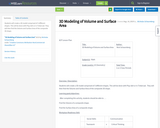
Students will create a 3D model comprised of 3 different shapes. This will be done with Play-doh or in Tinkercad. They will then find the Volume and Surface Area of the composite 3D shape.

Students will create a 3D model comprised of 3 different shapes. This will be done with Play-doh or in Tinkercad. They will then find the Volume and Surface Area of the composite 3D shape.
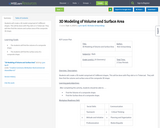
Students will create a 3D model comprised of 3 different shapes. This will be done with Play-doh or in Tinkercad. They will then find the volume and surface area of the composite 3D shape.
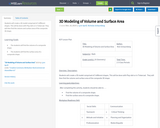
Students will create a 3D model comprised of 3 different shapes. This will be done with Play-doh or in Tinkercad. They will then find the volume and surface area of the composite 3D shape.

In this 5-lesson unit primary students identify attributes of buttons and other objects in their classrooms. Throughout the unit students learn to collect data about objects, display the data (Venn diagrams, pictographs, and bar graphs), and analyze the data to determine what this tells us about buttons and/or other objects. Each of the five lesson plans includes necessary student/class worksheets, questions for students, extension ideas, and assessment ideas. Lessons 2 and 3 reference stories that are an important part of the skill development: "The Button Box" by Margarette Reid and "The Elves and the Shoemaker" story.

This two-lesson unit from Illuminations, exposes students to algebra, measurement, and data analysis concepts and the major theme of analyzing change. In the first lesson, students measure the heights of classmates and older students and construct a table of height and age data to compare them. The second lesson's instructional goal is to understand how change in one variable, age, can relate to change in a second variable, height. Instructional plan, questions for the students, assessment options, extensions, and teacher reflections are given.
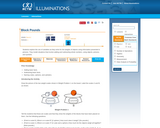
In this Illuminations lesson plan students explore the use of variables as they solve for the weights of objects using information presented in pictures. Learners model situations that involve adding and subtracting whole numbers, using objects, pictures, and symbols. A student activity sheet is available and downloadable (pdf).
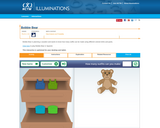
This interactive applet introduces students to the topic of combinations, a basic concept in probability. Users create combinations of shirts and pants to determine the total number of possible outfits. They may simply explore by placing the clothes on Bobbie, or make a guess and then test it. The number of shirt and pants choices is customizable. An optional voice provides prompts and feedback.
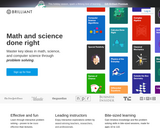
Learn through interactive problem solving – proven to be more effective than lectures. Enjoy interactive explorations written by award-winning teachers, researchers, and professionals. Brilliant guides you through an interactive exploration of concepts and principles, and helps you build your quantitative intuition. Learn frameworks for thinking and solving challenging problems, instead of memorizing formulas.
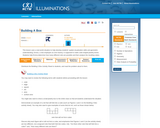
This lesson helps students develop spatial visualization skills and geometric understanding by exploring the different nets that can be folded into a cube. The lesson is placed in the context of a young woman who is trying to build a jewelry box. The lesson provides an activity sheet, a link to a helpful applet (Cube Nets, cataloged separately), questions for students and teachers, and ideas for assessment and extensions.
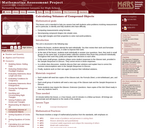
This lesson unit is intended to help teahcers assess how well students solve problems involving measurement, and in particular, to identify and help students who have the following difficulties; computing measurements using formulas; decomposing compound shapes into simpler ones; using right triangles and their properties to solve real-world problems.

This Java applet activity allows students to explore the various situations described in "The Chairs Around the Table" lesson (cataloged separately). The user can select Exploration mode, in which the number of chairs needed for a particular arrangement of tables is displayed; or Guess, in which the user is able to construct an arrangement and then predict the number of chairs. There are two types of tables to choose from and two different table arrangements. Instructions and exploration question are provide.
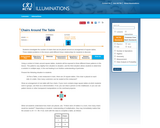
In this lesson from Illuminations, students explore and discover linear relationships. Linear patterns are identified, extended and described verbally, numerically and algebraically through three investigations. Using manipulatives and the linked applet, "Chairs", learners determine the number of chairs needed when the number of tables is known, and vice versa. Instructional plan, questions for the students, assessment options, extensions and teacher reflections are provided.
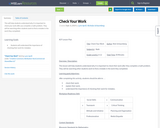
This will help students understand why it is important to check your work after you complete a math problem. They will be searching other students work to find a mistake in the work they completed.
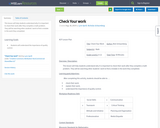
This lesson will help students understand why it is important to check their work after they complete a math problem. They will be searching other students' work to find a mistake in the work they completed.

This will help students understand why it is important to check your work after you complete a math problem. They will be searching other students work to find a mistake in the work they completed.

An applet for students to use in exploring the area and circumference of a circle in relation to its radius and diameter. When the radius is changed, the other measures automatically change and are shown on a board. Most importantly, the ratio between any pair of these measures can be shown.

This lesson develops number skills, understanding of coin values, and the concept of equivalence. Students use coin blocks, concrete representations of the value of coins (pennies, nickels, dimes, and quarters), to compose and decompose values up to a dollar. The resource includes a 3-minute video for teachers on how to build the coin blocks prior to the lesson. An interactive game, Coin Box, provides additional practice for students and is cataloged separately.

This 2-lesson unit focuses on combinations, a subject related to probability. Students develop strategies for discovering all the possible combinations in two given situations. They learn to collect and organize data and then use the results to generalize methods for determining possible combinations. They discuss how the number of possible outcomes is affected by decisions about the order of choices, or whether choices may be repeated. The unit includes student activity sheets, questions and extensions for students, and a link to an interactive applet.
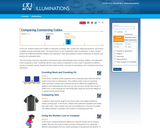
In this 6-lesson unit, students explore 5 models of subtraction (counting, sets, number line, balanced equations, and inverse of addition) using connecting cubes. The lesson activities focus on the comparative mode of subtraction as children investigate the relationship between addition and subtraction, write story problems in which comparison is required, and practice the subtraction facts. The lessons include printable student activity sheets, a bibliography of children's counting books, questions for student discussion and teacher reflection, assessment options, extensions, and links to online applets (cataloged separately).
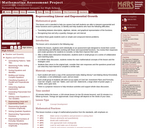
This lesson unit is intended to help teachers assess how well students are able to interpret exponential and linear functions and in particular to identify and help students who have the following difficulties: translating between descriptive, algebraic and tabular data, and graphical representation of the functions; recognizing how, and why, a quantity changes per unit intervale; and to achieve these goals students work on simple and compound interest problems.